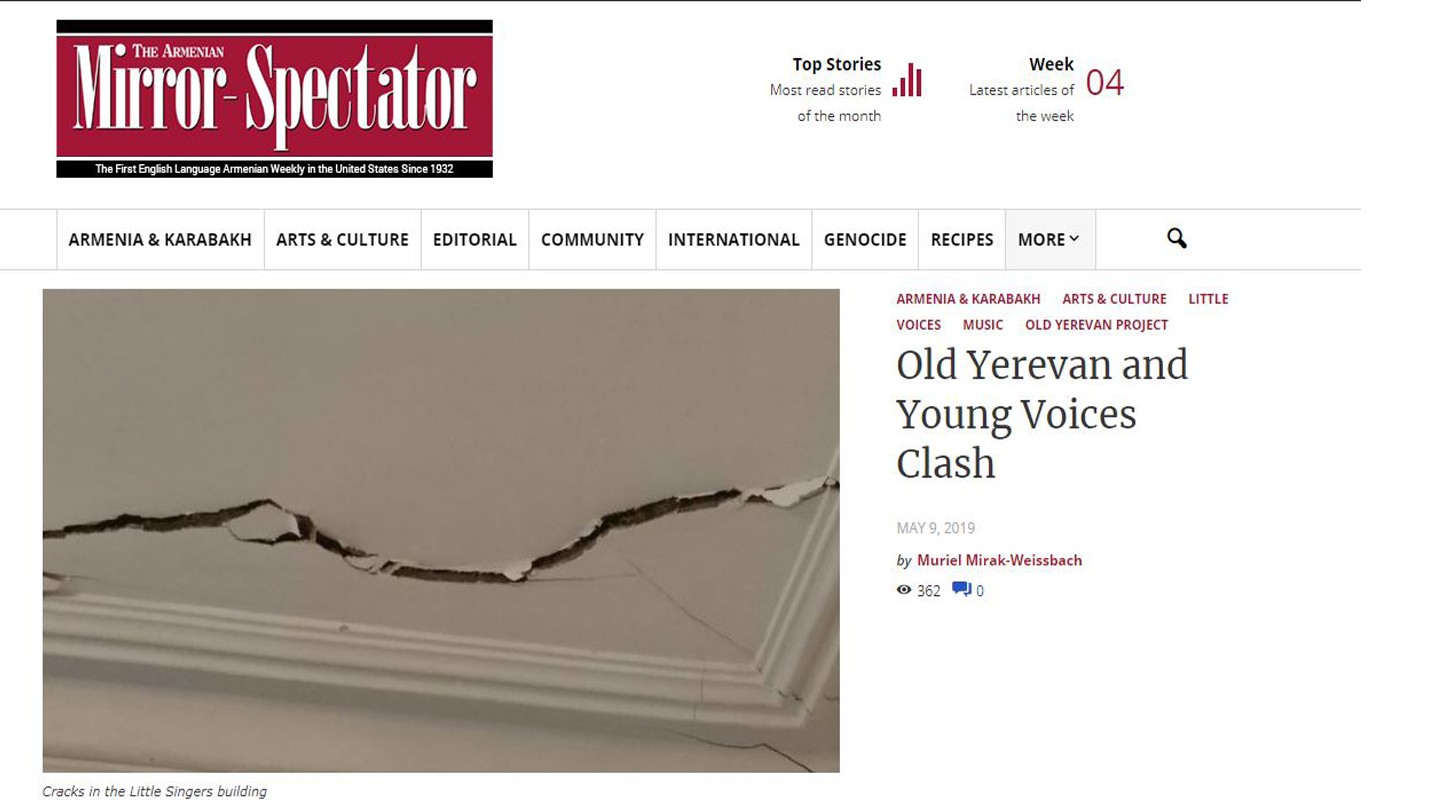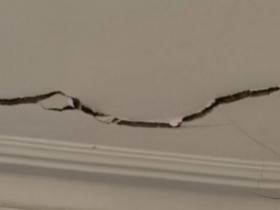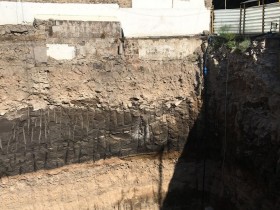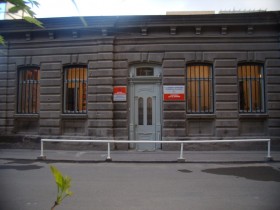
It was a bitter cold evening in January 2019. The noise emanating from the construction site in the center of Yerevan during the day must have been deafening: heavy pounding of steam shovels against the ground, whirring of earth moving machinery, and workers’ voices seeking to make themselves heard above the fray. That evening, without forewarning, came the sound of something massive, crumbling, smashing down onto the earth, while brown-grey clouds of dust and dirt rose up from the ground, obfuscating the view. The wall had come down and by a stroke of fortune none of the people inside were hurt.
It was not the Berlin wall, but the wall of a building on 23 Arami St., one of the four walls of a historic building that has been the “second home” of the Little Singers of Armenia since its founding in 1992. That is where they had been rehearsing.
No one should have been taken by surprise. Even without particular expertise in construction methods and building safety, one could have predicted that, if most of the old buildings on that city block were demolished, and a large hole were dug in the center of the large plot of land, the ground beneath building Nr. 23 would be affected.
In fact, the process leading to the collapse began earlier, in November 2018. And it certainly had to do with the hole. According to government regulations, the hole was supposed to be 10 meters deep maximum, but the one that was being dug went 15 meters down. It began right next to 23 Arami St. and earth-moving machines moved under tuff rocks of the building. One might have even thought the damage had been done on purpose, and in fact, gradually, the wall separated from the building.
On November 27, Prime Minister Nikol Pashinyan had visited the perilous site, viewed the damage and given instructions for repairing the building. But nothing was done. Then, less than two months later, the wall came tumbling down.
That was on January 11. As a result, the building was transformed from the venue of music rehearsals for the world-renowned children’s choir to a safety hazard. As documented in March 2019, the danger of further catastrophe was imminent; the continuing excavation work on the hole at Teryan Street and the heavy traffic at times involving three-axel vehicles and heavy machinery, add to the threat to the building, which is located at the juncture of Teryan, Byuzand and Arami Streets. There is a serious danger that the façade of the building on Arami Street will also collapse.
In April, my husband and I were in Yerevan and visited the site. We were not on hand when the first wall crumbled, but the description of the disaster above is not pure fiction. And we had been apprised of the danger as early as 2017, during our previous visit. My husband had photographed the building at the time, as well as the construction site, the area where the gaping hole would become bigger as time went by. Now, in 2019, we could only shake our heads in dismay.
Tigran Hekekyan, the founder and director of the Little Singers, brought us up to date on developments. In an attempt to save the building, he was circulating a petition that had been signed by numerous artists. The petition, entitled “Children’s Choir in Dire Danger!” is addressed “To the developers of the ‘Old Yerevan’ project, the Yerevan Municipality, the Urban Development Committee of the RA, and the Government of the RA.” It states that the future of the choir is in danger. “The historical monument where the rehearsals of the choir ‘Little Singers of Armenia’ are held is on the verge of collapse. The building’s structural integrity has been compromised as a result of illegal construction that is being carried out under the guise of the ‘Old Yerevan’ project.”
The petition goes on to report that the choir has had to suspend activities as a result, its last performance having been on October 11, in the context of the 17th Francophonie summit held in the Armenian capital. The petitioners demand that the structural integrity of the building be restored “and that a temporary venue be accommodated” until the security of the original building is guaranteed.
Calling on “individuals all over the world” to support their efforts, the petitioners stress that they seek “to prevent not only the collapse of the historic building, but also to protect the Little Singers,” so they “can work and share the light of love and goodness all over the world.” Among the signers of the petition are: Gudz Manoukyan, Tigran Mansuryan, Armen Khandikyan, Yervand Ghazanchyan, Arkadi Ter-Tadevosyan, Vigen Chaldranyan, Armen Elbakyan, Khachatur Martirosyan, Artavazd Peleshyan, Armenouhi Karapetyan, Arthur Utmazyan, Avetis Berberyan, Mkrtich Minasyan, Vagharshak Zakaryan, Hrant Vardanyan, Rouben Barbayan, Gagik Ginosyan, Narine Tukhikyan, Aram Satyan and Svetlana Navasardyan.
Hekekyan told us, in closing, that the Old City Closed Joint Stock Co., which organized the construction work, had refused to realize a reconstruction plan proposed by Italian architects and that the same plan had not yet been confirmed by the Yerevan Municipality. In the meantime, the Little Singers were starting rehearsals in rented office space, with a lease that can be extended only for three-month periods.
In the petition reference is made to the “Old Yerevan Project”: “The developers,” the text reads, “want to take possession of the Little Singers of Armenia choir’s building, to demolish it and use the entire property for their project.” It continues that due to “The authorities’ passivity and the aggressive behavior exhibited by the developers,” the matter will end up in the courts, “most probably in the European courts,” which could “drag on for many years.” To be able to continue their work, the choir would need a new location, which could cost $5,000 a month.
The Old Yerevan Project presents itself as a program of urban development aimed at preserving the historic the old city of Yerevan. Photos on the website www.oldquarter.am document the demolition of those buildings, and the reader is to assume that they will be reconstructed, to conserve the original design and structure. Instead, it appears that a “tourist pedestrian zone” is to come into being, and “comfortable showrooms, cafes, restaurants … exhibition halls and museum-shops, art galleries, small hotels … are expected to be built.” Indeed the name Old Yerevan should not be taken literally; it “is conditional and does not mean the creation of an ethnographic quarter, but the re-creation of the historical and architectural environment. In the architectural interpretation of the project, the harmony of old and new forms is used….”
According to an article in EVN by Lilit Margaryan on April 4, this is not the whole story. (https://www.evnreport.com/raw-unfiltered/chronicles-of-the-old-yerevan-quarter) In the 1970s, architect Levon Vadanyan had the idea of protecting the buildings in the historic area that go back to the pre-Soviet era and are characterized as “black buildings” for the use of black stones, but to no avail. Demolition began in the Soviet period and continued even after independence. By 2005 there was very little left and in that year the Old Yerevan Project was set up. The designated area, enclosed by Arami, Abovyan, Byuzand and Koghbatsi Streets, was divvied up into five lots and auctioned off to three private companies. Years later most of the area was declared to be eminent domain and was taken over by the Old City Company. The plan for restoration was indeed an urban development plan, foreseeing non-residential buildings, cafes, restaurants, galleries, shops, etc. all under a 7,000-square-meter glass dome. The historical monuments originally located on the site had been divided into three categories: those to be restored, those to be rebuilt with what was left of the original stones, and those to be demolished and replaced by new structures.
According to an earlier article by Ani Mshetsyan in ArmInfo, there was an interdepartmental consultation in 2017 in which Vardanyan participated, with Narek Sargsyan, chairman of the State Committee for Urban Development of RA, and employees of the Ministry of Culture and Yerevan City Hall. (https://finport.am/full_news.php?id=31291&lang=3) At that meeting, plans were discussed for implementation, which parts of the area and which buildings were to be restored or reconstructed. Mshetsyan refers in the article to plans by Vardanyan to include a two-story underground parking lot as part of the project.
The home of the Little Singers on 23 Arami Str. fell victim to the construction work. Lilit Margaryan reports that Vardanyan, as author of the project, had slated the building for dismantling and reconstruction at any rate, on grounds that the sidewalks were too narrow and had to be widened to three meters. The building was “on the edge of the street,” he said, and “it would be taken apart and moved back three meters. This means we are keeping the building in the same area,” he is quoted as saying.
Be that as it may. The fact is, construction work on the property where the building stands was carried out, with authorization of the Yerevan Municipality at the time, and in violation of technical requirements related to urban development. Due to the incompetent work, the building suffered massive damage. Reportedly the Ministry of Culture filed a criminal lawsuit with the General Prosecutor’s office. Since then the ministry has been phased out.
An Expert’s Evaluation
Michael L. Sahakian, a technical consultant, examined that matter and issued his findings on March 27, 2019 to the Prime Minister Nikol Pashinyan, with copies to the Mayor of Yerevan Haik Marutyan and Chairman of Urban Development Vahagen Vermishyan. In introducing his study of the failed excavation, he stated that he himself, “in 50 years of Project Management, Engineering and Construction internationally, … has experienced such a predicament due to natural causes but never seen one with such human incompetence.” He added that a Site Safety Manager, Hamo Hayrapetian, certified by the City of New York, accompanied him in his inspection and shared his conclusions.
Sahakian’s document explains the technical reasons for the disaster deriving from the faulty construction work, which led to accumulation of excessive liquid, aggravated by rainfall, heavy traffic, and other factors. The storm drain catch basin at Arami Street and Byuzand collects surface runoffs, but the water has nowhere to drain except underground. “All four sides may collapse anytime due to various causes,” he writes, and points to the “junction of Arami and Teryan adjacent to the Armenian Little Singers International Building, a landmark of Armenian architecture.” He forecasts the collapse of the structure, which “may involve loss of human lives and public property not to mention the landmark building.” He specifies that it is not a question of “if” but “when” the disaster would occur, which would necessitate closing the road and entail a huge financial burden for reconstruction.
In his view, this very complex problem requires coordination by the City Building and Safety Department, with the cooperation of experts in foundations soils who have experience in excavation. In addition, “an expert licensed structural engineer is conjunction with the foundations expert jointly need to study and design the remedy” which entails “a complete constructability review.”
The report concludes: “Both the writer and the Safety Manager are American Armenians with Armenian citizenship also. We have supported the Prime Minister from the days of the amazing Campaign and Revolution. We continue to strive for a better Armenia. We think it would be an unfortunate situation if a disaster occurs; it won’t go on the account of the past government but on the watch of the present one in the eyes of the world and the opposition.”
Protecting Architectural History
How should one preserve the architectural heritage of a nation? Since the collapse of the Berlin Wall 30 years ago and the subsequent reunification of Germany, followed by the independence of the former Soviet republics and the regained sovereignty of nations of eastern Europe, enormous efforts have been made to revive the beauty of great urban centers, especially in the capital cities. In Berlin, Warsaw, Budapest or Prague, to name a few, this has come about through careful restoration of architectural wonders that had fallen into decay, or outright reconstruction of those deemed past repair. The results vary in excellence but where the aim has been to recover the past architectural achievements, replicas of the original buildings have come into being that maintain the integrity of the original, to the degree possible.
In the case of the Old Yerevan Project, it appears that the aim of project author Vardanyan was not to restore monuments but to “recreate an environment.” He has compared his vision to the Vernissage open air market in Yerevan, saying that the current one is “in an embarrassing state.” He says one should “imagine a luxurious version of the Vernissage,” where there would be makers and sellers of carpets, or silver jewelry and the like. As for solving the problem of those dismantled buildings, whose stones have disappeared or been severely damaged, he thought the problem was not restoration of monuments but what he calls the recreation of the “environment“ of the old city. “I do not need the sign to say ‘Monument’,” he explained in 2014, “I want my grandchildren to grow up and see that Yerevan looked like this in the 19th century.” (https://www.armenianow.com/society/59183/armenia_old_yerevan_project_presentation)
But did Yerevan look like the drawings of the project? For architect Karen Balyan, the Vardanyan approach is “pseudo-architecture and a theatrical approach to architecture.” One should restore historical structures, in Balyan’s view, as has been done in Tbilisi for example, not build anew. For architect Sashur Kalashyan, a member of the Yerevan City Hall Urban Development Council, Vardanyan’s idea is artificial, and would create not an urban environment, but a public resort zone.
For the Little Singers of Armenia the issue goes beyond aesthetics. On April 15, A. Vardanyan, who is the Head of the Division of the Programs of Special Regulation of Urban Development Activity, responded to the petition issued on behalf of the Little Singers. Welcoming the professional contributions made by the choir, the writer expressed his concern for the situation caused by the construction work associated with the Old Yerevan Project and announced that his office had sent an appropriate letter to the construction companies “Old City” CJSC and “EMC” CJSC, urging them to implement the necessary measures with regard to securing, maintenance and sale of existing property at the designated location.


